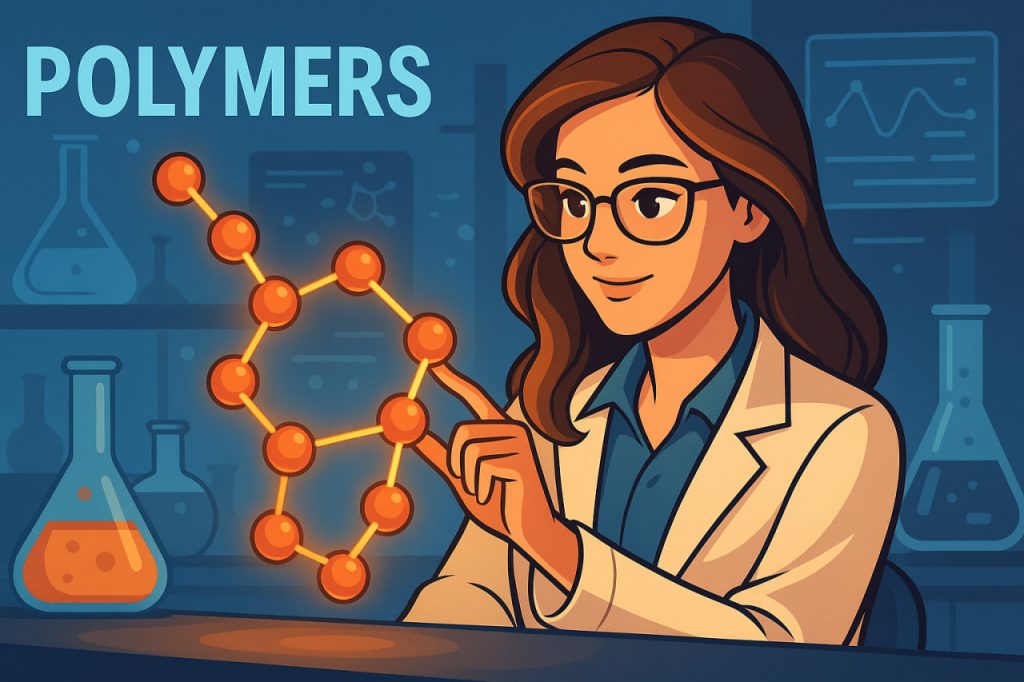Polymers are among the most versatile and widely used materials on Earth, forming the backbone of modern life — quite literally in some cases. From the DNA inside our cells to the plastics in our homes and the fibers in our clothes, polymers are everywhere. Their unique molecular structure allows them to be incredibly strong, flexible, and lightweight, making them essential in industries ranging from medicine to aerospace. Understanding what polymers are and how they work helps explain how chemistry shapes the world we live in.
What Are Polymers Made Of?
A polymer is a large molecule composed of repeating smaller units called monomers. These monomers bond together through a process known as polymerization, forming long chains that can stretch, twist, or fold into various shapes. Natural polymers include substances like cellulose, silk, rubber, and DNA, while synthetic ones include nylon, polyethylene, and Teflon. The properties of a polymer — whether it’s soft, hard, elastic, or heat-resistant — depend on the type of monomers used and how they’re linked together. For instance, the same chemical elements can create both soft rubber and hard plastic depending on the arrangement of molecular bonds.
Types of Polymers and Their Characteristics
Polymers can be categorized based on their origin, structure, and thermal behavior.
- Natural Polymers – Found in nature, such as proteins, starch, and chitin.
- Synthetic Polymers – Man-made materials like polystyrene or PVC.
- Thermoplastics – Soften when heated and harden when cooled, allowing recycling.
- Thermosetting Polymers – Once set, they cannot be remelted; examples include epoxy resins.
- Elastomers – Highly elastic materials such as natural rubber and silicone.
This classification helps engineers and chemists choose the right polymer for specific applications, from food packaging to medical implants.
How Polymers Are Formed
Polymerization can occur through two main mechanisms: addition polymerization and condensation polymerization. In addition polymerization, monomers simply join together without losing atoms, as seen in the production of polyethylene from ethylene gas. Condensation polymerization, on the other hand, involves the release of small molecules like water during bonding — this process forms materials such as nylon or polyesters. Advances in chemistry have allowed scientists to control polymerization reactions precisely, tailoring molecular architecture to achieve desired strength, flexibility, or conductivity.
The Role of Polymers in Nature and Biology
Nature was the first polymer chemist. Biological macromolecules like DNA, proteins, and cellulose are natural polymers that make life possible. DNA, for example, is a polymer made of nucleotide monomers, encoding genetic information that determines the traits of all living organisms. Proteins, composed of amino acid monomers, serve as enzymes, hormones, and structural components of cells. Even plant cell walls owe their rigidity to cellulose, a natural polymer that has inspired synthetic materials. Biopolymers have also become models for sustainable innovations — scientists now design biodegradable plastics that mimic the decomposition of natural polymers.
Applications of Polymers in Modern Technology
The versatility of polymers has transformed nearly every aspect of human civilization. Lightweight polymer composites are used in aircraft and automobiles to reduce fuel consumption, while medical-grade polymers create artificial joints, contact lenses, and biodegradable sutures. In electronics, polymers serve as insulating materials and flexible components in wearable technology. Even the renewable energy sector depends on polymers for solar panels and wind turbine blades. Dr. Rachel Evans, a materials scientist at Cambridge University, notes that “polymers are not just materials — they’re design platforms for the future.”
Environmental Challenges of Synthetic Polymers
Despite their usefulness, synthetic polymers — particularly plastics — pose serious environmental problems. Many are non-biodegradable, persisting in the environment for centuries. Microplastics, tiny fragments resulting from polymer degradation, have been found in oceans, soil, and even human blood. According to the United Nations Environment Programme (UNEP), over 400 million tons of plastic waste are produced annually, with less than 10% being recycled. Researchers are now developing bio-based and degradable polymers made from renewable resources like corn starch or algae, aiming to reduce the ecological footprint of polymer production.
Innovations and the Future of Polymer Science
The next generation of polymers focuses on smart materials — those that can respond to environmental changes such as temperature, light, or pH. These include shape-memory polymers, which return to their original form after deformation, and conductive polymers used in flexible electronics and sensors. Scientists are also exploring self-healing polymers that can repair cracks automatically, extending product lifespan. As nanotechnology and polymer chemistry merge, new possibilities emerge for drug delivery systems, artificial organs, and sustainable energy solutions.
Expert Insights
Experts agree that the future of polymers lies in sustainability and functionality. Polymer chemist Dr. Takashi Yamada emphasizes that “the challenge is to balance performance and biodegradability — creating materials that serve human needs without harming the planet.” Meanwhile, environmental scientist Dr. Elaine Brooks advocates for global regulations to ensure responsible production and recycling. The scientific community’s goal is clear: transform polymers from environmental burdens into sustainable innovations.
Interesting Facts
- The word “polymer” comes from Greek: poly (many) and meros (parts).
- Spider silk, a natural polymer, is stronger than steel of the same thickness.
- Biodegradable polymers can decompose in less than six months under the right conditions.
- Polymers make up more than 50% of modern car materials by volume.
- The first fully synthetic polymer, Bakelite, was invented in 1907.
Glossary
- Polymerization – The chemical process by which monomers bond to form polymers.
- Monomer – A small molecule that can link with others to form a polymer.
- Thermoplastic – A polymer that softens when heated and hardens when cooled.
- Thermosetting Polymer – A polymer that hardens permanently after being heated.
- Elastomer – A highly elastic polymer that can stretch and return to its shape.
- Biopolymer – A natural polymer produced by living organisms.
- Microplastic – Small plastic fragments resulting from the breakdown of synthetic polymers.
- Smart Material – A polymer that changes its properties in response to environmental stimuli.
- Nanocomposite – A material made by combining polymers with nanoparticles for enhanced properties.
- Biodegradable Polymer – A polymer capable of decomposing through natural biological processes.


